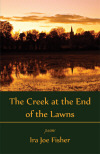The Creek at the End of the Lawns
In capturing the people and place of a small town, Ira Joe Fisher’s fourth poetry collection forges a strong relationship to form, meter, and rhyme. A keen sense of reminiscing for past ghosts filters through poems that range from brief lyrics to grander narratives. The Creek at the End of the Lawns resurrects the need for the performative aspect of poetry in terms of storytelling and mythmaking, prompting the reader to speak these poems aloud rather than remain silent.
In capturing the people and place of a small town, Ira Joe Fisher’s fourth poetry collection forges a strong relationship to form, meter, and rhyme. A keen sense of reminiscing for past ghosts filters through poems that range from brief lyrics to grander narratives. The Creek at the End of the Lawns resurrects the need for the performative aspect of poetry in terms of storytelling and mythmaking, prompting the reader to speak these poems aloud rather than remain silent.
Grounding the framing poems of the collection, the title poem, in swift iambic pentameter, delves into questions of place and who has (or does not have) the right to tell its stories and secrets. Beginning with a preface, the poem, with the assistance of a narrator figure, guides the reader through Annville’s landscape to a young man named Finch, who
writes these Annville lessons down.
And the very ink of those words vibrates
Into streams from the brittled, yellowing
Paper.
These words manifest into a ghost, Alfred, who questions Finch’s “leave to tell town tales.” An ensuing section depicts a conversation between Finch and Alfred, including a witty exchange of dialogue around the reliance of memory. Commentary from the narrator supports this fast-paced dialogue, claiming
No person can remember everything.
Oh, people remember only little;
The poet notices and remembers
Most, nearly all, and he lives to remind
Mortal forgetters . . .
“The Creek at the End of the Lawns” is framed by two sections of shorter, more lyric poems. Some poems remain unrhymed with short, quick lines and breaks, while others subtly employ regular meter and rhyme schemes. These brief glimpses into landscape reflect the power of observation. In “Ars Poetica,” varying line lengths in a single stanza provide a set of instructions directing the reader to pay attention to each sensory detail, to
See the leaves
seldom stilled,
see the leaves joyed and jostled
by wind in cool, blued afternoon
which must be kept
and held often and forever.
Each small detail builds upon the previous one as the poem progresses, guiding the reader to mentally record each small moment. The poem culminates in the lines asking for time to be recorded as
Each next minute
must be noted
like a host at church,
like a glowing song from a far place.
Readers who enjoy seeing how rhyme and meter—more commonly associated with older, more “traditional” poetry—can still be used in contemporary poetry will want to follow these varied and skillfully wrought poems closely. Constantly questioning the permeability of time and the static yet changing nature of place, Fisher’s poems lend credence to the power of memory to “gather, visit, and listen” the specifics of each minute moment that matters.





